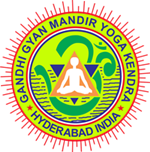- Introduction
- I. NETI KRIYA (NOSE CLEANING PROCESS)
- II. DHAUTI KRIYAS
- III. VASTI KRIYA (Enema)
- IV. NAULI – AGNISAR – UDDIYAN KRIYAS
- V. KAPALBHATI, BHASTRIKA KRIYAS
- VI. TRATAK KRIYA
Introduction:
Limbs, eyes, ears, nose, mouth etc. can be termed as external organs of the body. There are many more internal organs in our body. We clean our external parts twice or thrice a day or whenever any dust or dirt accumulates on them. We do so because we see them. Then how about internal organs? The dirt accumulated on or in them is not visible, so we don’t pay any attention to keep them clean as we do for our external organs. Cleanliness of internal organs or parts is much more important than the external ones. Our Munis and Yogis have prescribed many processes to clean and remove out the unwanted matter accumulated in the internal organs of the body. These may be done either before or after practicing Yogasanas. There are six major cleaning processes in Yoga. They are:
NETI KRIYAS : Jala (water), Ksheer (milk), Tail (oil), Ghrit (ghee), Sutra (thread), Swamutra (self urine), Gomutra (cow urine), Neti Kriyas (nose cleaning processes).
DHAUTI KRIYAS: Jala (water), Vamana (vomit), Vastra (cloth), Danda (stick), Dhauti Kriyas (stomach cleaning processes).
VASTI KRIYA : Vasti (enema) and Shankh Prakshalan – (large intestine cleaning processes).
NAULI KRIYAS : Agnisar, Uddiyan, Nauli (navel rotation processes for purifying abdominal organs).
KAPAL BHATI : Bhastrika-Kapalbhati (forceful breathing processes for purifying the skull and brain).
TRATAK: Continuous gazing (eye cleaning processes).
Nose, ear, mouth and throat are generally cleaned by Neti process; stomach by Dhauti; intestines by enema; abdomen by Nauli; skull and brain by Kapalabhati and eyes by Tratak processes. The six processes deal with the delicate organs so the practitioners should consult the experts while attempting. It is always better to do them under the guidance and in the presence of experts for five or six times. Then one can do by self.
I. NETI KRIYA (NOSE CLEANING PROCESS):
Cleaning of nose (nose cleaning processes) has become unavoidable in these days, as the air in the atmosphere particularly in the towns and cities is polluted to its maximum. Neti kriyas help to clean the nose.
1) 1. Jalaneti Kriya:
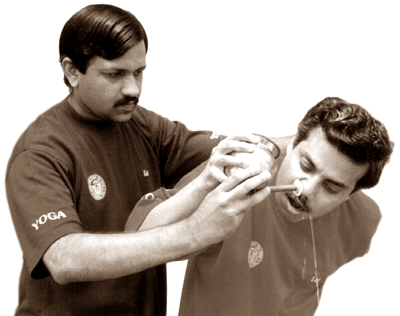
A little common salt should be dissolved in luke warm water and filtered. Fill it in a specially designed tubed tumbler with a nozzle. Stand up tilting forward a little. Now turn the head a little to the right. Place the nozzle of the tumbler in the right nostril and bend the tumbler such that the water flows into the nostril. Breathe in and breathe out through the mouth only. The water that enters into the right nostril comes out from the left nostril automatically, carrying out the dirt in the nose. Entire tumblerful of water should be poured into the right nostril. Now tilt the head to other side and repeat the same process through left nostril with another tumblerful of same water. Throughout this process breathing is through mouth only. After cleaning both the nostrils, close the ears with the thumbs. Breathing in fully through the mouth, release it through the left nostril with great force closing the mouth. Similarly breathe in fully through the mouth close the mouth and breathe it out with great force through the right nostril. Then sneeze out through both the nostrils. Repeat the same till the last drop of the water is thrown out from the nostrils. If any water drops are left in the nostril it may effect cold. Specially manufactured tubed brass, copper or plastic Neti tumblers are available in Yoga Kendras. It is very good for the health to clean the nostrils through the above process everyday.
2. Advanced process:

Warm saline water is taken in a Neti tumbler or in a glass. The water is to be taken in through one nostril and let out through the mouth. It is repeated through another nostril. After practicing through both the nostrils individually, water is taken in through both the nostrils simultaneously from a wide opened cup and released out from the mouth. Later water is sucked into the mouth and exhaled or sent out through the nostrils with force. This is a bit difficult one.
3. Jalanasapaan (drinking water through nose):

After satisfactorily cleaning the nostrils thoroughly, drinking water through nose, is called Jalanasapaan. Water is taken in through nostrils and spit out once or twice. Then water is drunk through nose as conveniently as it is drunk through mouth.
2) Ksheera Neti Kriya:
As in Jalaneti, instead of saline water, warm filtered milk is used in this process. Milk is filled in Neti tumbler and the stages of Jalaneti are followed.
If the milk is a bit concentrated, little warm water may be added to dilute and then filtered before the process.
Note: Ksheera Neti Kriya should invariably be followed by the Jalaneti Kriya.
3) Swamutra (Self urine) / Gomutra (Cow urine) Neti:
Early morning self urine may be collected in a Neti vessel and the process similar to Jalaneti is done. Similarly fresh cow urine may be used for this process.
Ksheera, Swamutra, Gomutra Neti Kriyas may be practiced occasionally followed by Jalaneti+forceful breathingout process.
4) Tail (Oil), Ghrit (Ghee-melted butter) Neti Kriyas:
One has to lie down on the back and bend the head a little back. 5 to 6 drops of warm oil or ghee are to be poured through nostrils, and rest with slow and deep breathing for a while in the same position. Coconut, Til or any other edible oil or pure ghee may be used. This may be practiced either in the afternoon or in the night before going to sleep.
5) Sutra / Rubber Neti Kriya :
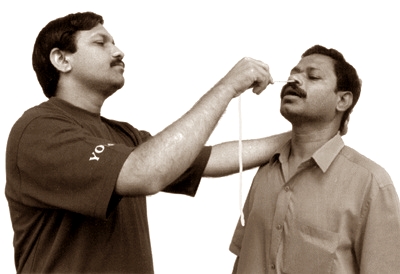
Specially prepared cotton thread or a rubber catheter of about 18” length and 3 to 4mm thick is inserted in the right nostril and brought out from the mouth with the help of two fingers. Then both the tips are held and forward – backward movement is done 5 to 10 times after which the thread is removed out from the mouth. Similarly the process is repeated through other nostril also.
While the thread is inserted inhalation should be through nose and exhalation through mouth. After completing Sutra Neti, gargling with warm water should be done for some time followed by Jalaneti Kriya and Tail or Ghrit Neti Kriya.
Experienced Sadhaks can insert two threads into both nostrils, tie them and arrange such a way that finally the thread can come out from other nostril.
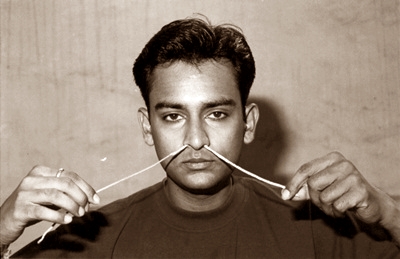
Note: All Neti Kriyas should necessarily be followed by Jalaneti Kriya and then Bhastrika Pranayaam.
Jalaneti Kriya may be done everyday while other Netis can be done once a week, and get wonderful benefits by sparing just few minutes every day.
Advantages:
Neti Kriyas cleanse the nasal passage. Problems related to ears, nose, throat and eyes are prevented. Lot of improvement is seen in cases of dumbness, baldness, oozing ears, red eyes, watering eyes, sinusitis, loss of memory, lack of concentration, head-ache, migraine. It has a very soothing and calming effect on brain, so that anxiety, depression, and negative thoughts are controlled. The aspirant of Neti remains always cheerful and happy.
II. DHAUTI KRIYAS (Stomach cleaning Processes):
Dhauti means washing. It is called Udara Shudhi, stomach wash in Yoga science.
1. Jala Vaman Dhauti Kriya:
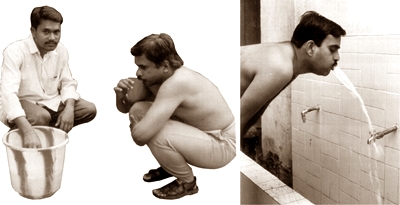
Elephants follow this process, when they are ill. So it is also called Kunjal Kriya or Gajakarni (Kunjal = Gaja = Elephant). Yogis learnt this by observing elephants. Water is heated to luke warm, little salt is added and filtered. Squatting on the feet, drink the saline water till stomach is full to its maximum say eight to ten glasses in succession. Stand up and drink further half to one glass of same water and then move the waist front and back, left and right and rotate it clockwise and anti clockwise three to four times. With this movement the unwanted acids, gases and other wastes accumulated in the stomach are mixed in the drunk water. Now bend before a wash basin, press the stomach with the left hand and press lightly the inner tongue with the two right pointed fingers. With this sensation, the water in the stomach gushes out like a spring or fountain from the mouth bringing the accumulated wastes out.
Hold the fingers inside the mouth and go on tickling the inner tongue till the entire drunk water is vomited out. If at all a little water is remained that is let out either through stool or through urine.
Note: Finger nails should be trimmed or else the soft palate may be hurt and blood may start oozing.
Saline water turns red when unwanted acids mix in it. During this process red water may come out. It is not blood. After the completion of the process either Arogyamritam or warm milk or both should be taken. Later a little rest is a must. After this process spiced food like pakodas, mirchees etc. should not be taken on that day. Non-veg food also should not be taken. This activity should be undertaken atleast once a week. If needed it may be practiced continuously for two or three days.
Note: People suffering from High B.P. should use lime juice instead of salt. People suffering from ulcers, heart diseases or any stomach disorder or pregnant women should not attempt this process.
Advantages:
Stomach is cleaned. Gastric trouble, constipation, indigestion, acidity, burning sensation in the stomach, head-ache etc. are relieved. Even the extra weight of the body is also reduced gradually. If it is done regularly Jaundice does not effect. People suffering from breathing problems get relief.
2. Vastra Dhauti Kriya:
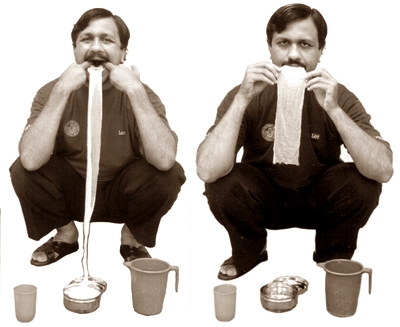
3 inches wide and 4 to 7 meters long thin and soft clean muslin cloth stripe is taken. It is soaked in the luke warm saline water for a while. Under the guidance of the experts, the cloth is gradually swallowed inch by inch till the last tip is remained in the hand. The outer end of the cloth is to be tied to the fingers to avoid complete swallow. At the beginningonly 12 to 15 inches of cloth is swallowed and gradually pulled out. Generally it takes 5 to 10 days to practice with entire cloth.
After Vastra Dhauti Kriya, Jala Dhauti Kriya is a must. After that warm milk should be taken compulsorily. We should take only light food on the previous day and the day we do Vastra Dhauti Kriya.
Note: Vastra Dhauti Kriya should be practiced only after continuously doing Jala Dhauti Kriya for seven days. It can be done daily till the problems are solved. Thereafter may be done once a week.
Advantages:
Cough, phlegm, asthma, gases and other lungs and stomach disorders, headache, fever, skin diseases like itches, eczema etc. are cured through this process. Appetite is developed. Yogis and munis used to swallow a special stick of creeper wood for cleaning the stomach. This is called Danda Dhauti Kriya. Now the number of people following this process is reduced to minimum and only few yogis practice it.
III. VASTI KRIYA (Enema) :
Either lime juice or neem leaves paste is added to warm water and the enema pot is filled. A rubber tube is fitted to the hole of the enema pot. The other end of the rubber tube is inserted into anus in lying position. The water enters the large intestine. The abdomen is gently massaged with the palms. The impurities flush out along with the enema water. So it should be practiced near to the toilet.
In ancient days the rishis and the Yoga practitioners used to sit in a water tub or a river or in a tank and suck the water into the stomach through anus. Their willpower helped them in this process. Now there are only a few people, who can do it, so the water is conveniently sent in by enema process these days.
When we pass out the water, gases, acids and other dirt particles that have been accumulated in the large intestine gush out. After enema one should take rest for some time and should take light food on that day. Enema should be taken empty stomach before breakfast. Enema can be taken once a month or whenever one feels.
Advantages:
Large intestine is thoroughly cleaned. Constipation and indigestion problems are solved. Appetite is increased.
IV. NAULI – AGNISAR – UDDIYAN KRIYAS:
Navel movements are involved in Nauli Kriyas:
Breathing in, holding the breath, breathing out play an important role in these Kriyas.
1. Agnisar Kriya:
Some experts opine this as a Dhauti Kriya. One has to spread a good cloth, carpet or blanket on the floor and sit on it in the Vajrasan posture and inhale in fully and exhale totally leaning forward a little. Now holding the breath out the stomach is moved front & back in quick successions till one can hold the breath outside. Thereafter slowly the air is inhaled and all the parts of the stomach are gradually brought to their normal position. This is called one chakra or a round. One may practice 3 to 4 such rounds.
The Agnisar Kriya can be practiced in the standing posture also in the same way.
2. Uddiyan Kriya:
One should sit either in Sukhasan or Padmasan on a small pillow. First inhale in and then exhale totally through mouth. Holding the breath outside, the stomach should be sucked in to its maximum, so that it seems touching the backbone. After being in that state for some time inhale slowly. It is repeated 3 to 4 times. This can be practiced even in standing position in the same way.
3. Nauli Kriya:

After practicing Agnisar Kriya and Uddiyan Kriya perfectly, then only one should attempt Nauli Kriya. Making center of the abdomen as a pipe is important in this exercise. The practitioner has to stand and keep his hands on thighs and inhale to maximum and exhale totally. Now the abdomen is sucked in such a way that it touches the back bone. At this stage, the center of the abdomen is turned as a vertical pipe. Gradually one hand is lifted from the thigh and raised. The pipe like abdomen is moved from one side to the other. Then another hand is raised and the process is repeated.
Note: Nauli Kriya is to be attempted after attending to the calls of nature, empty stomach before breakfast. It should never be attempted after meals. People below 14 years of age or suffering from fever or high blood pressure, ulcer, hernia and pregnant women should not attempt Nauli Kriya.
Advantages:
Nauli Kriya cures the diseases of stomach and liver, increases appetite – removes potential disabilities.
Nauli Kriyas such as central nauli, right nauli, left nauli etc. are to be practiced strictly under the guidance of experts.
V. KAPALBHATI, BHASTRIKA KRIYAS:
1. Kapalbhati:
It is the process of cleaning the brain and the central top of the head. Breath should be inhaled fully upto navel and should be exhaled three to four times with maximum force. Inhalation should be natural but exhalation should be deliberate & forceful. While exhaling it should be breathed out through the nose with hissing sounds. This kriya has become prominent recently as Pranayaam also.
Advantages:
This activity sharpens the thinking ability, inculcates selfconfidence and also helps in developing the memory and knowledge. It makes the face charming.
2. Bhastrika:
Bhastrika is also like Kapalbhati Kriya. Breath is continuously inhaled and exhaled without any interruption. Forceful exhalation is important in Kapalbhati, whereas inhalation and exhalation both are equally forceful in Bhastrika. This is also Pranayaam.
Advantages:
Bhastrika helps in reducing gases, constipation and acidity.
Note: Chest and abdomen should be expanded when breathing in and they should be contracted when breathing out in both Kapalbhati Kriya and Bhastrika.
VI. TRATAK KRIYA:
Continuous gazing an object is called Tratak.
1. This is an eye activity. Sit in one posture constantly without moving and gaze at a particular object constantly like $ or any other symbol placed at a distance of about two feet parallel to the height of the eye on a wall without blinking for as long as possible.
2. A candle may be lit and placed on a small table or a stool at the parallel height of the eye and sit at a distance of two feet from it and practice Tratak Kriya continuously as long as possible.This must be done in a dark room.
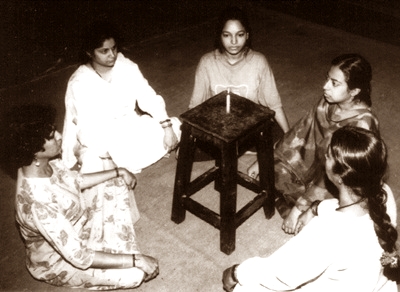
3. Hand may be stretched straight keeping the thumb up. The thumb may be looked at constantly as long as possible.
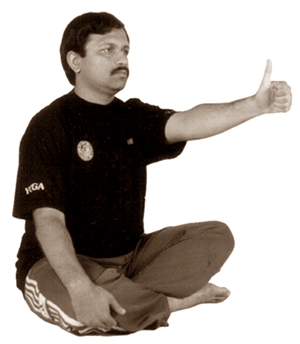
If one feels burning sensation in the eyes or tears roll in the eyes the practice should be immediately stopped. The same may again be mentally practiced with closed eyes also.
Soon after the completion of the Tratak exercises, palms should be rubbed thoroughly to warm. The warm palms are placed on the closed eyes for some time.
4. Other Tratak Kriyas can also be practiced by gazing at an Idol, photo, orange colour raising sun, full moon or symbols like 3, c, 8, x,u etc.
5. Eye Wash : After Tratak Kriyas, eyes are cleaned with water by using especially designed eye wash cups which are available in Yoga centers. Fill two eye wash cups with pure drinking water, lower the head and place these eye cups on the closed eyes. Slowly raise the head, blinking the eyes so that the water enters into the eyes and they get cleaned.
After few seconds remove the eye cups and throw away the water. Repeat the same process again filling the cups with fresh water.
Advantages:
Eye diseases are prevented, sight is improved, concentration develops, will power increases and mind feels peace and calm. It is an excellent preparation for meditation.
![]()
People used to follow these six activities. They were the part of routine life in olden days. We have to practice them deliberately as special activity these days, because there is air pollution, water contamination and food adulteration everywhere. Under these circumstances the importance of these Shatkriyas or the six activities has increased and everyone has to take benefit by learning and then regularly practicing.
![]()
